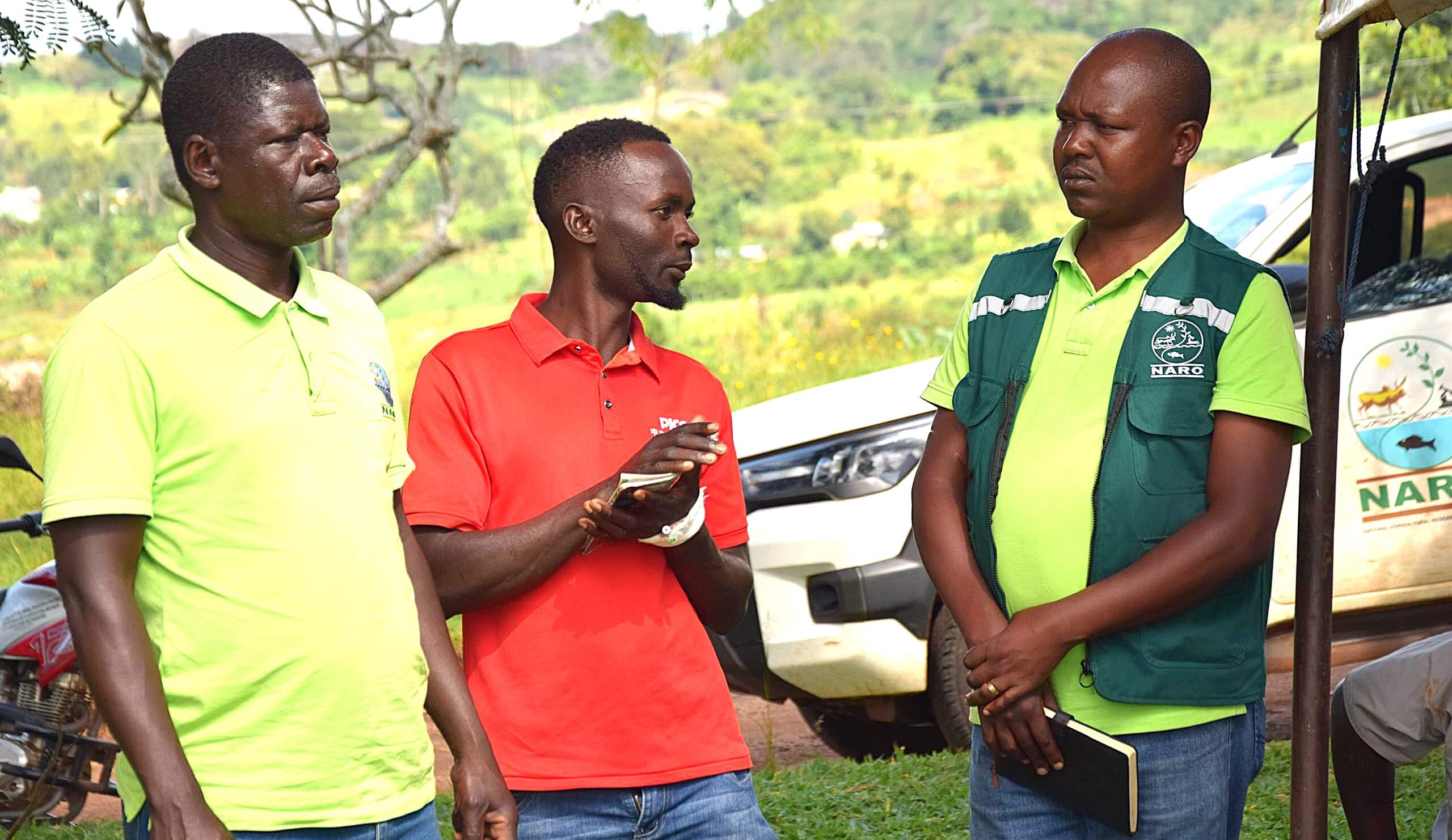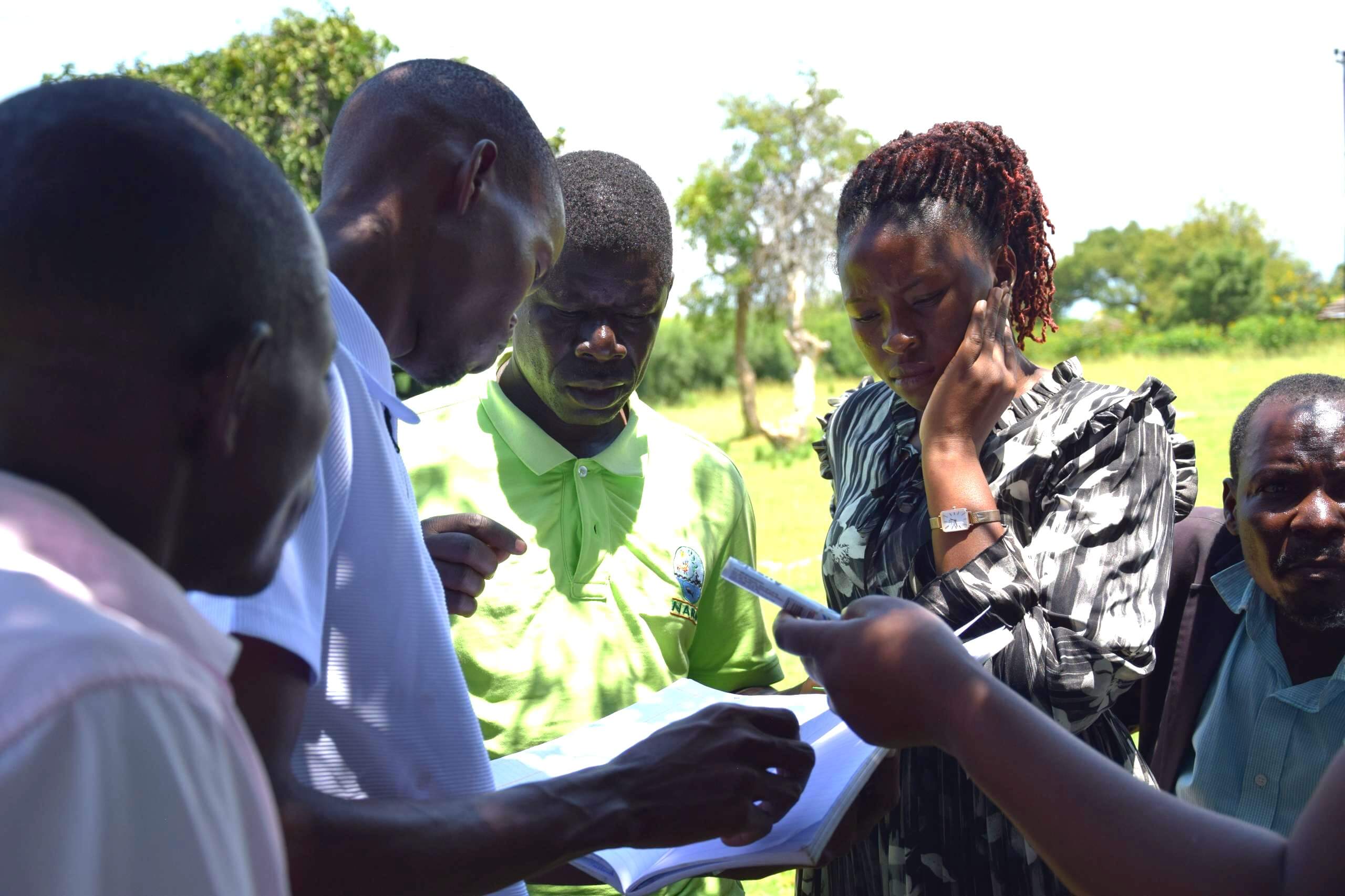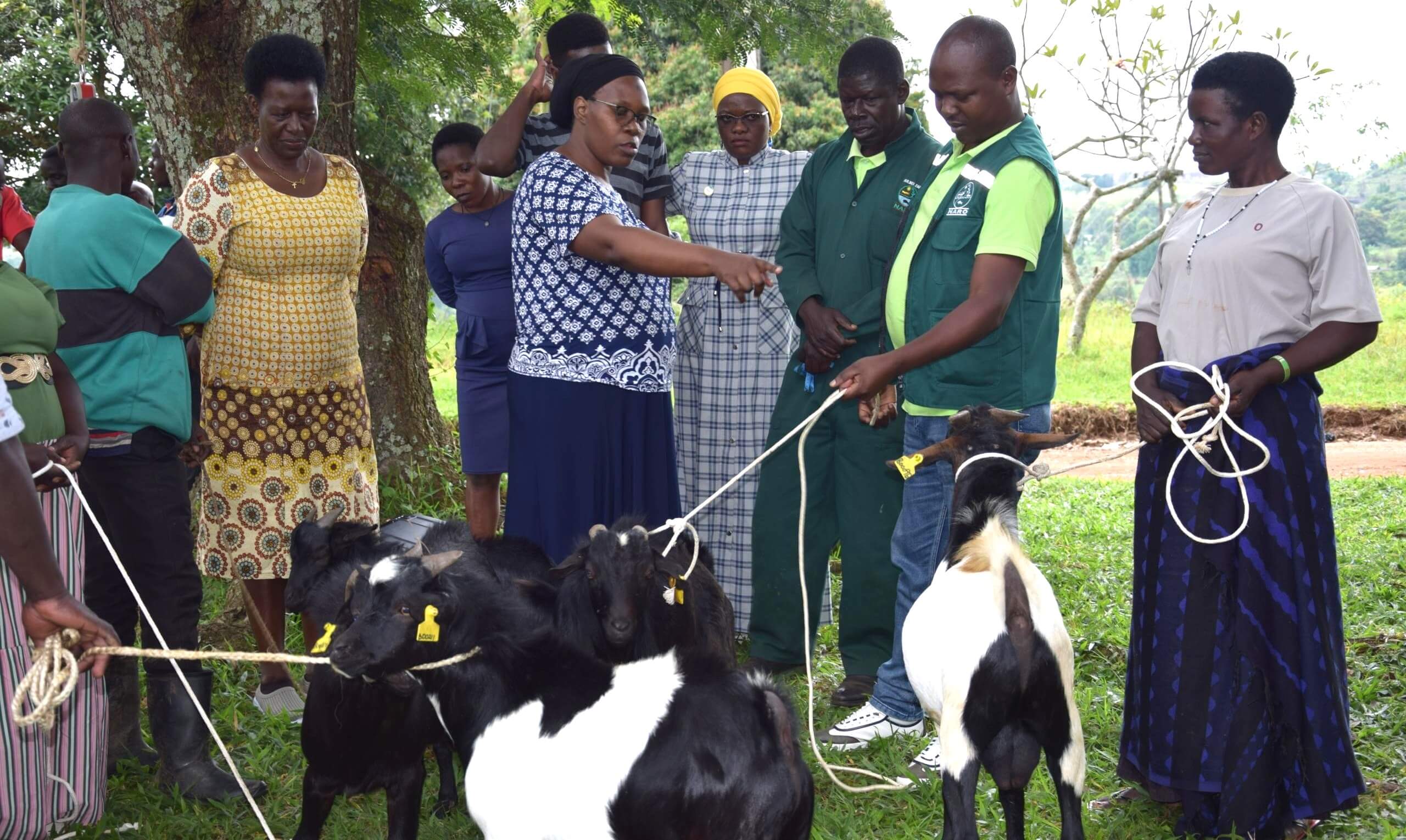
- This event has passed.
Breeding for Resilience: Western Uganda’s Farmers Take Charge of Saving the Indigenous Goat, thanks to AICCRA Project
BY MICHAEL WAKABI & BEN MOSES ILAKUT
With support from ASARECA, NARO, and global research partners, communities in Kibaale and Buliisa embark on a new chapter of sustainable livestock improvement through Community-Based Breeding Programmes.
In the hills and lowlands of Kibaale and the oil-rich plains of Buliisa, a quiet revolution in livestock farming is taking shape. For decades, farmers in these Western Uganda districts have depended on indigenous goats for meat, income, and cultural functions. Yet, years of unplanned breeding and neglect have eroded the productivity and resilience of these hardy animals. Now, under a new initiative led by the Association for Strengthening Agricultural Research in Eastern and Central Africa (ASARECA, and Uganda’s National Agricultural Research Organization (NARO), local farmers are being empowered to rebuild and protect the genetic strength of their native goat breeds.
Between October 7th and 9th, 2025, pioneer cohorts of goat breeders in the two districts received a consignment of carefully selected breeding bucks. The handovers marked the operational launch of Community-Based Breeding Programmes (CBBPs) for Small Ruminants — a participatory model designed to enable communities to collectively select, breed, and improve livestock suited to their environments.

In both Kibaale and Buliisa, the initiative has stirred enthusiasm among farmers who see goat keeping as an accessible path out of poverty. “We are really grateful to NARO,” said Atuhaire Justine, Treasurer of the Buseesa Livestock Farmers Association in Matale Sub-County, Kibaale District. “We have received five male goats that will help us improve our local breeds. For years we struggled with inbreeding and declining productivity. Now we are going to breed goats that are hardy, fast-growing, and have quality meat and skin. Within five years, we expect to have more goats and better incomes.”
Reviving the Mubende Goat
At the centre of the initiative is the Mubende goat, an indigenous breed prized for its adaptability, quality meat, and resistance to disease — but now under threat from crossbreeding and neglect.
“There is a real danger that Uganda’s indigenous goat breeds are fast disappearing,” warned Dr. Zuena Nantongo, a livestock breeder at the Nakyesasa Livestock Research Institute in Namulonge. “This project is a mitigation strategy against total dependence on exotic breeds that cannot withstand our local conditions. The Mubende goat is hardy, can achieve weights comparable to the Boer, and has excellent twinning potential. With proper selection and care, we can enhance its productivity while preserving its genetic traits.”

Dr. Nantongo explained that the initiative seeks to tackle one of the biggest problems undermining goat farming in rural Uganda — lack of quality breeding males. “In most flocks, the males are old, and many females are mated by their brothers or even fathers, leading to inbreeding and poor performance. Through CBBPs, we identify and distribute superior local males to communities, record their performance, and select the best offspring for future breeding.”
The programme employs a structured cycle of data collection and selection, tracking each goat’s growth and reproductive performance from birth. Farmers record weight gain, twinning rates, and resistance to disease. Goats that perform below the community’s average are excluded from the breeding pool, while those showing superior traits are retained and promoted. Over successive generations, this approach is expected to yield a stronger, faster-growing, and more marketable local goat.

Farmers Take Ownership
For the farmers, the project’s most empowering element is that the community is in charge. Unlike top-down interventions where scientists dictate breeding choices, the CBBP approach positions farmers as both decision-makers and data collectors. “We thank ASARECA and Bulindi ZARDI for choosing Buseesa Livestock Farmers Association to do goat breeding,” said Charles Sekisaasi, the association’s secretary. “We’ve been given five locally sourced bucks, and we’re ready to start. Before this project, we couldn’t tell a pure Mubende goat from a crossbreed. Now we can. The Mubende goat is disease-resistant, requires little care, and its meat is highly valued in the market. Through this project, we hope to save our disappearing breed.”

Moses Mwesigwa, Acting Director of NARO’s Bulindi Zonal Agricultural Research and Development Institute (BuZARDI), emphasized the economic potential: “Poverty is bad, but everyone can rear a goat and make their way out of it. Successful goat production depends on three things — breed, nutrition, and care. While we can help fix the breed, nutrition is 65 percent of the outcome, and that’s in the farmers’ hands,” Mwesigwa told farmers during the handover ceremony.
Local government officials are equally optimistic. Tumwesigye Solomon, the Animal Husbandry Officer representing the Kibaale District Veterinary Officer, noted that the district looks forward to seeing a goat that “is adapted to our conditions, grows fast, and delivers good meat and weights.”

Science Meets Community Wisdom
The CBBP initiative in Western Uganda is part of a broader regional effort to transform small ruminant production systems through participatory genetic improvement. Implemented under the Accelerating Impacts of CGIAR Climate Research for Africa (AICCRA) project, it is supported by the World Bank and led by the Alliance of Bioversity International and CIAT, working in collaboration with ILRI, ICARDA, ASARECA, and NARO.
The project aims to build the technical and institutional capacity required to scale up climate-smart agricultural innovations across Africa. It focuses on integrating climate information services, strengthening partnerships, and validating technologies that improve productivity and resilience in farming systems.
“The Community-Based Breeding of Indigenous Goats in Uganda is an AICCRA-supported initiative,” explained Annet Hadijah Wanyana, ASARECA’s Head of Finance, who led the handover team. “We’ve provided breeding bucks, 5,000 ear tags, and applicators to help track the performance of each animal. But the biggest responsibility lies with farmers — in how they manage, feed, and care for the breeding stock. Goat farming is a viable enterprise, and demand in domestic and export markets is growing. The more effort you put in, the more benefits you’ll reap.”

Training for Transformation
The handover ceremonies followed an intensive training and sensitization programme held between August 25–29, 2025, in Kibaale and Buliisa. The sessions introduced farmers to the principles of community-based breeding, good husbandry practices, and record keeping. The training also focused on gender inclusion, youth participation, and climate resilience — essential pillars of sustainable livestock development.
According to ASARECA, the objectives of the training were multifaceted:
- To raise awareness and promote adoption of CBBPs among goat farmers;
- To build the capacity of researchers, extension agents, and farmers (especially women and youth) to design and manage breeding programmes;
- To enhance knowledge on goat welfare and production systems;
- To strengthen collective production and marketing efforts; and
- To promote inclusive knowledge exchange through south–south learning.

The programme draws lessons from Ethiopia, where the CBBP model has been in operation for over 16 years. According to Dr. Aynalem Haile, a small ruminant breeder and ICARDA’s Country Coordinator for Ethiopia, the project there started, with only six farmers. Today, CBBPs cover over 300 villages, and nearly every home has goats. The evidence is clear — community-based breeding improves livelihoods. It empowers farmers, increases income, and preserves local breeds.”
A Model Rooted in Inclusion and Climate Resilience
One of the defining strengths of CBBPs is their inclusiveness. By integrating women and youth in breeding activities, the programmes create opportunities for broader participation in the livestock economy. Women, who traditionally own and manage small ruminants, gain recognition and income, while young people acquire practical skills in animal husbandry and data management.
Furthermore, the emphasis on indigenous breeds makes the programme a strategic response to the twin challenges of climate change and genetic erosion. Indigenous goats like the Mubende have evolved to thrive under Uganda’s variable climate, surviving droughts and limited feed where exotic breeds often fail. By improving their performance rather than replacing them, researchers are promoting climate-smart adaptation rooted in local biodiversity.

The initiative also fosters community solidarity. By pooling animals, data, and decision-making, farmers are learning to operate collectively rather than as isolated individuals. This approach strengthens their bargaining power in the marketplace, promotes knowledge sharing, and builds resilience against shocks such as disease outbreaks or feed shortages.
From Research to Livelihood Impact
For NARO and its partners, the CBBP rollout in Kibaale and Buliisa is a milestone in translating research into tangible livelihood impact. It bridges the gap between scientific knowledge and community action, placing innovation directly in farmers’ hands.
“Ultimately, our goal is to produce a goat that grows faster, gives twins or triplets, and meets both household and market needs,” said Dr. Nantongo. “We are not introducing a new breed — we are improving what farmers already have, using science to amplify the best of local genetics.”

The project’s data-driven structure ensures that every step is evidence-based. Through regular monitoring of growth, reproduction, and survival rates, researchers and farmers can jointly evaluate progress and make informed breeding decisions. As the breeding cycles progress, the programme will also generate critical information for national livestock policy and breed conservation efforts. In the long term, Uganda could establish a national database of indigenous goat genetics, supporting sustainable breeding beyond project sites.
Goats as a Pathway Out of Poverty
Goat farming may seem modest, but in rural Uganda, it represents a vital economic lifeline. Goats are easier to raise than cattle, reproduce quickly, and fetch steady income from meat, milk, and skins. They also serve as a “bank on hooves” — an asset that can be sold in times of need.
According to NARO’s projections, a well-managed flock of improved indigenous goats can more than double a household’s income within five years. As market demand for goat meat continues to rise both domestically and regionally, farmers stand to benefit from better breeds, improved husbandry, and collective marketing.
The handover of breeding bucks in Kibaale and Buliisa may appear symbolic, but it marks the first step in a much larger transformation — one that blends traditional livestock wisdom with modern science, community participation, and climate resilience.
As the sun set over the hills of Kibaale and Buliisa, farmers led their new breeding bucks into waiting pens — symbols of renewed hope. From here on, the future of Uganda’s indigenous goat may well rest in the capable hands of the very communities that have kept it alive for generations.
ends
